
Orders
The orders screen provides information about all orders in your eCommerce system. To access it, go to Ektron CMS400.NET Workarea > Settings > Commerce > Fulfillment > Orders.
Warning! In order to process orders, the Distributed Transaction Coordinator (DTC) Windows service must be running. It is started by default when you install Ektron CMS400.NET.
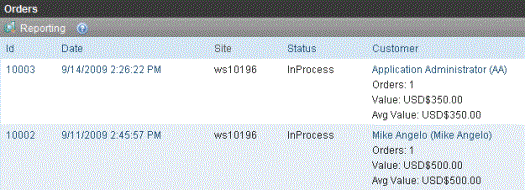
Initially, orders are sorted by submission date and time, with the most recent at the top.
Selecting Orders by Criteria
You can select orders by any of the following criteria.
entry date range
customer
catalog entry
To use any filter, choose Reporting (see below) then the appropriate filter option.
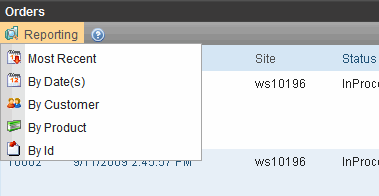
Note: The Most Recent menu option is the default select and sort order: all orders with the most recent on top.
See Also: Orders
Order Statuses
Note: The following table assumes you use the default workflow installed with eCommerce. If you customize the workflow, the following table may be inaccurate. See Also: Customizing Workflows”
|
Status |
Description |
How Set |
|
Received |
Order has been submitted. |
Site visitor submits order |
|
Fraud |
Your organization has determined that the order is fraudulent. |
View Order Screen > Action Menu > Mark as Fraud |
|
Shipped |
Order has been shipped Note: This status can be the workflow’s end point. You do not need to use the Completed status. |
View Order Screen > Action Menu > Ship Order or View Order Screen > Action Menu > Enter/Edit Tracking Number > Check Mark as Shipped checkbox and save |
|
Completed |
All order activities are finalized. No events can occur to a Completed order. |
View Order Screen > Action Menu > Process Order |
|
Cancelled |
Order has been cancelled. |
View Order Screen > Action Menu > Cancel Order |
|
InProcess |
Automatically assigned when order is submitted. |
Order placed but not yet captured |
The View Order Screen
To view the details of any order, click it. When you do, the View Order screen appears. From this screen you may view the following about the order.
Summary (shown below)
Status
Payment
Coupons
Address
Description
Workflow
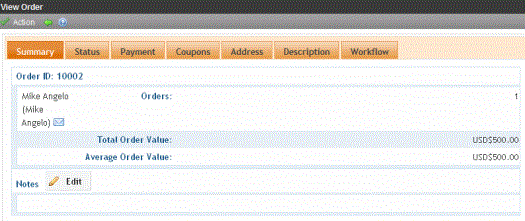
Note: If the View Workflow option does not display a flowchart, verify that the server’s Distributed Transaction Coordinator (DTC) Windows service is running. It is started by default when you install Ektron CMS400.NET, but if it stops for some reason, the Workflow does not appear on this screen.
The View Order screen’s Action menu has the following options.
Mark as Fraud Marking the Order as Fraud
Edit Tracking Number Entering a Tracking Number
Cancel Order Canceling the Order
You can also edit the order’s billing and shipping addresses. See Editing an Order’s Billing and Shipping Addresses.
These options are explained below.
Capturing the Order
Authorization versus Capture
Authorization occurs while a customer is using the Checkout server controls. It submits a customer’s payment information to a payment gateway, bank, or PayPal, and returns either an approval with an authorization number (transaction ID) or a decline along with an explanation.
Capture is the process of submitting encrypted order information (including the transaction ID) to a payment gateway account, bank, or PayPal. At this time, the account is charged for the order amount.
Note: * In many states, you must ship an item before you can charge a customer’s credit card for it.
* Items that are not tangible are automatically captured if paid by PayPal or a credit card. See Also: Tangible Item
Next, you receive confirmation from the paying agency that the money has been deposited to your account and is available. At this time, you use the Mark as Settled option to inform the eCommerce feature that payment has been received. This changes the order status to Complete.
|
Payment Method |
Tangible item |
Intangible Item |
|
PayPal or credit card |
When goods are shipped |
When customer submits order |
|
Check |
When check clears |
When check clears |
See Also: Payment Options
The Capture
To capture an order, follow these steps.
1. From the Ektron CMS400.NET Workarea, choose Settings > Commerce > Fulfillment > Orders.
2. Click the order that you want to capture.
3. Click Payment (see illustration below).

4. The View Payment screen appears, showing information about the transaction captured when the site visitor submitted his payment information.
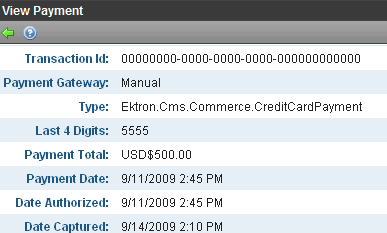
5. Choose Action > Capture.
6. You are asked to confirm the action.
7. Click OK.
Canceling the Order
Click Action > Cancel Order to stop all processing on the order. If you do, the order’s status changes to Canceled.
Entering a Tracking Number
When an order is shipped, the shipping provider typically provides a tracking number to help locate the shipment within the delivery chain. Use the Enter Tracking Number option to enter this part of the order information.
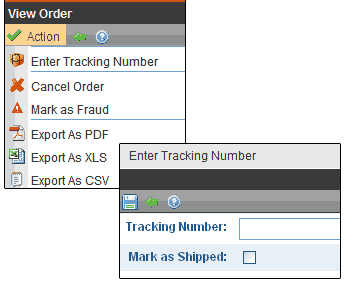
After entering the tracking number, you can indicate whether the order has shipped.
Viewing the Tracking Number
You can see an order’s tracking number on the View Order screen, under the Shipping Address (as illustrated below).
![]()
Marking the Order as Fraud
Use this option if your organization determines that the order is fraudulent. These orders cannot be processed any further.
Marking the Order as Shipped
To denote that an order has shipped, follow these steps.
Note: If that order has not yet been captured, it will be captured as part of the shipping of the order.
1. From the Ektron CMS400.NET Workarea, choose Settings > Commerce > Fulfillment > Orders.
2. Click the order that is being shipped.
3. Choose Action > Ship Order.
Alternatively, you can mark the order as shipped while entering its tracking number. See Also: Entering a Tracking Number
Editing an Order’s Billing and Shipping Addresses
To edit an order’s billing or shipping address, click Edit as circled below.
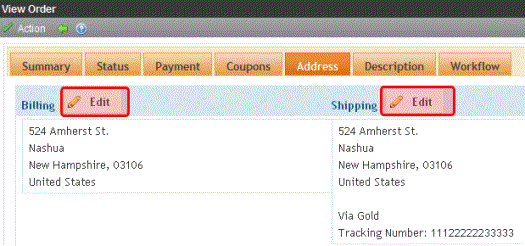
Order Workflow
Ektron CMS400.NET uses Microsoft’s Windows Workflow Foundation to create and implement order process workflows to handle the ordering process. The workflow can be as simple or complex as your business requires.
For example, you could have a simple workflow that sends one email to the customer when an order is received, and another to your shipping department. Or, you could have a more complex workflow that:
sends an email to the customer when the order is received
checks to see whether the item is a tangible product or a virtual product. Then, continues down the workflow path that’s appropriate for the item.
handles shipping notifications and updates the account throughout the
shipping process
handles the order if it is canceled
handles the order if it is determined to be fraudulent
marks the order as complete once all activities are finished
For more information on workflows, see Customizing Workflows.


